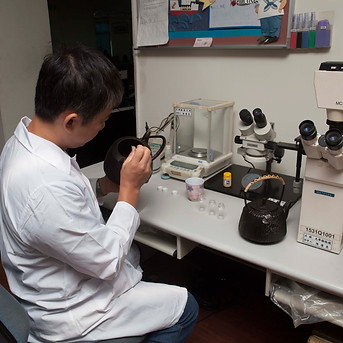Behind The Scenes
Ceramic Shell Mold Casting Technology: Innovation, Refinement, and Attention to Detail

In order to make safe and healthy ironware for families, TAKU uses ceramic shell mold casting (also known as investment casting) instead of the traditional sand casting method. Sand casting uses river sand, which can be reused over and over and also leaves a rough surface texture. However, it is difficult to control the sand’s source and purity. By using ceramic shell mold casting, our products are safer and purer with a more elegant and smooth surface texture than can be achieved vs sand casting.
At TAKU, we use refined ceramic materials to create durable products. During the production process, TAKU carefully coats the model its products will be made from with these materials seven times while maintaining the correct ambient temperature and humidity for optimal results. Each ceramic model is only used once to ensure each TAKU product has the highest quality possible.
The Raw Material Difference: Use of Pollutant-Free Pig Iron Ore
The iron casting process requires a temperature of 2552 degrees Fahrenheit to smelt iron ore. Due to cost considerations, most manufacturers’ raw material consists of recycled scrap iron. However, this practice can create quality and safety concerns.
At TAKU, we believe the quality of our raw materials is a crucial factor in the quality of our final products. We carefully research and choose our suppliers and import pure, pollutant and radiation-free pig iron ore from Brazil, Russia and South Africa that is certified for material safety. During TAKU’s production process, quality is also strictly monitored to provide truly safe products to our customers that offer peace of mind.
_JPG.jpg)
Practical Design through Scientific Analysis: Lighter, More Durable Cast Iron Products

Cast ironware made via traditional sand casting cannot be used with cold water while hot due to risk of cracking. At TAKU, our use of ceramic shell mold casting creates durable and high-density cast ironware that can tolerate sudden temperature changes.
Compared to other manufacturers, TAKU’s products have slightly thicker bottoms (0.157 inches, or 4 mm), but is thinner overall (0.0984 inches, or 2.5 mm). As a result, TAKU products are more lightweight than competing products, yet still retain the characteristics of cast iron such as heat retention, thermal conduction and strength.
In studying the history of cast iron manufacturing, we discovered that Japanese artisans did not apply any paint on the inside of their cast iron products. That way, the inside of their teapots leach iron into the water. This leached iron supplements our iron intake and is beneficial to our bodies. In addition, it helps water and food taste smoother and more flavorful.
Quality Assured Every Step of the Way
TAKU’s pig iron ore consists of 95% iron, 3% carbon, and 2% silicon, the optimal combination for making cast ironware. Before production begins, each batch of pig iron is inspected with a spectrometer to ensure the iron ore is free of poisonous heavy metals.
Each piece of TAKU Ironware is created via a dedicated production line. Throughout the entire process, each station follows strict quality assurance and quality control standards to ensure TAKU delivers the very highest quality cast ironware to our families and friends.

Our Commitment to Quality Extends to the Details: A Lacquer That’s Natural, Practical, and Safe

At TAKU, we’re committed to delivering healthy and safe products to families and friends. For this reason, we use natural, chemical-free lacquer made from organic plants on the outside of all our products, creating an elegant traditional satin finish that prevents rust and gives them a distinctive blue-grey hue.
One-of-a-Kind Products with Collectible Value
TAKU’s artisans create each cast ironware product one at a time, resulting in every piece being striking and unique. This is especially prominent in our special and limited editions. Not only do our cast iron products exemplify a rich Chinese cultural heritage, but also a uniquely Taiwanese spirit.

